Mad Hedge Biotech and Healthcare Letter
February 15, 2022
Fiat Lux
Featured Trade:
(AN EMERGING LEADER IN THE HEALTHCARE REVOLUTION)
(CRSP), (VRTX), (EDIT), (NTLA), (PFE), (NVS), (GILD), (RHHBY), (BMRN), (QURE), (SGMO), (CLLS), (ALLO), (BEAM)

Mad Hedge Biotech and Healthcare Letter
February 15, 2022
Fiat Lux
Featured Trade:
(AN EMERGING LEADER IN THE HEALTHCARE REVOLUTION)
(CRSP), (VRTX), (EDIT), (NTLA), (PFE), (NVS), (GILD), (RHHBY), (BMRN), (QURE), (SGMO), (CLLS), (ALLO), (BEAM)

Mankind has always imagined a future filled to the brim with technological advancements serving as the panacea to all our ills.
One of the prevailing ideas focuses on the developments found in the healthcare sector.
Movies, television shows, graphic novels, and books have all pictured a world with such revolutionary technologies capable of not only diagnosing but also curing any and all types of diseases.
Since the introduction of these ideas, many have believed that these would remain in the fictional universe. However, these “ideas” have slowly transformed into reality.
One of the biggest indicators that we’re heading in that direction is the 2020 Nobel Prize in Chemistry by Jennifer Doudna and Emmanuelle Charpentier. The two were recognized for their pioneering work in CRISPR-Cas9.
Basically, Crispr-Cas9 functions like molecular scissors.
What makes this technology incredible is that Crispr-Cas9 can classify a single address out of 3 billion letters within the genome by using only a particular sequence. With this, we can repair thousands of genetic conditions and even offer more potent ways to battle cancer.
This Nobel Prize led to commercializing the 2012 discovery, Crispr-Cas9, at breakneck speed, with gene-editing companies like CRISPR Therapeutics (CRSP), Editas Medicine (EDIT), and Intellia Therapeutics (NTLA) gaining a considerable boost in their values.
Surprisingly, the trajectory of these gene-editing stocks took a tragic turn in 2021.
In fact, the once-upon-a-time-market-darling CRISPR Therapeutics saw its market capitalization brutally shaved off from $8.7 billion to $4.55 billion in the past months.
No matter how we look at it, there’s genuinely no way to sugarcoat the reality: the market has been second-guessing CRISPR Therapeutics’ ability to truly deliver on its promise.
That is, investors have started to wonder whether the company’s early stage success would amount to anything commercially.
CRISPR Therapeutics is currently working on a treatment that would implant tumor-targeting immune cells on cancer patients. The company is also prioritizing therapies that could edit cells to treat diabetes.
So far, it has made significant progress in developing treatments for a genetic disorder called sickle cell.
In the US alone, at least 100,000 people suffer from sickle cell disease, with 4,000 more born every year. Conservatively, we can estimate at least 3,000 patients availing of this one-time treatment at over $1.6 million a pop.
To date, CRISPR Therapeutics has five candidates under clinical trials for diseases like B-thalassemia, sickle cell disease, and other regenerative conditions.
It has four more queued, which target diabetes, cystic fibrosis, and Duchenne muscular dystrophy.
Compared to its rivals in the space, it’s clear that CRISPR Therapeutics is ahead when it comes to product development and trials.
Two of its candidates, transfusion-dependent beta thalassemia treatment CTX001 and sickle cell disease therapy CTX110, have already been submitted for clinical tests for safety and efficacy.
Recently, Vertex (VRTX) boosted its 2015 agreement with CRISPR Therapeutics by 10%, with the deal reaching $900 million upfront to push for quicker results in developing CTX001.
This is a crucial move for Vertex, but more so for CRISPR Therapeutics as CTX001 holds a highly lucrative addressable market.
The additional funding significantly widened the gap between the Vertex-CRISPR team and bluebird bio (BLUE) in the race to launch a new gene-editing therapy targeting sickle cell disease and beta thalassemia.
To sustain its growth, CRISPR Therapeutics’ strategy is to develop drugs that only require mid-level complexity but can rake in generous financial rewards.
This is a similar tactic used by bigger and more established biotechnology companies like Pfizer (PFE), Novartis (NVS), and Gilead Sciences (GILD).
Evidently, this strategy is a great way to ensure cash flow.
Aside from its earnings from the commercialization of these products, CRISPR Therapeutics can also attract larger companies to buy the intellectual property of their breakthrough treatments.
After all, startups generally get 100% premiums in contracts with Big Pharma.
Good examples of this are Novartis that bought AveXis and Roche’s (RHHBY) purchase of Spark Therapeutics.
The Roche-Spark agreement led to the first ever FDA-approved treatment since gene therapy trials started in the 1990s. It was for the genetic blindness therapy Luxturna, which received the green light in 2017.
The second approved treatment was a muscle-wasting disease therapy Zolgensma, which was the fruit of the Novartis-Avexis acquisition.
Both conditions are rare, but the financial rewards are impressive.
At $2 million for each treatment, Zolgensma sales reached $1.2 billion annually. At the rate the therapy is selling, Novartis estimates that Zolgensma will surpass the $2 billion mark in 2021.
Novartis and Roche aren’t the only ones partnering with smaller gene editing companies.
Pfizer has been working with biotechnology companies BioMarin Pharmaceutics (BMRN) and UniQure (QURE) to develop a treatment for blood-clotting disorder hemophilia.
The COVID-19 frontrunner is also collaborating with Sarepta Therapeutics (SRPT) to come up with a treatment for Duchenne muscular dystrophy.
Gene editing has also served as the foundation for several biotechnology companies out there today like Sangamo Therapeutics (SGMO), Cellectis (CLLS), and Allogene Therapeutics (ALLO).
The market size for gene editing treatments is estimated to be worth $11.2 billion by 2025, with the number rising between $15.79 billion to $18.1 billion by 2027.
This puts the compounded annual growth rate of this sector to be at least roughly 17%.
While this is already groundbreaking with only a handful of companies knowing how to utilize the technology, the gene-editing world has come up with a more advanced technique than Crispr-Cas9.
The technology is founded on the “base editing” or “prime editing” technique, which is the simplest type of gene editing that alters only one DNA letter.
So far, one company holds exclusive rights to this technology: Beam Therapeutics (BEAM).
When the technology became public, Beam stock has increased sixfold since its IPO in February 2020.
This latest development can resolve thousands of genetic diseases. However, it still requires further trials since “base editing” can also trigger damaging responses from the body.
Overall, I think CRISPR Therapeutics is the most promising among these high-risk stocks.
The data from two of its candidates, CTX001 and CTX110, are promising. The added funding from Vertex boosts the confidence of investors that a regulatory approval is well on its way.
The company is also sitting on a massive cash pile and investing aggressively across different rare disease programs.
While the company has yet to be considered a major force in the biotechnology world, the potential multiple successes of its products could generate a company worth hundreds of billions.
This potential alone offers an investing opportunity with a substantial asymmetric advantage for its current share price.
However, bear in mind that the stock is not for conservative investors considering risks.
More importantly, its pipeline requires patience. Hence, CRISPR Therapeutics should be played as a long-term investment.
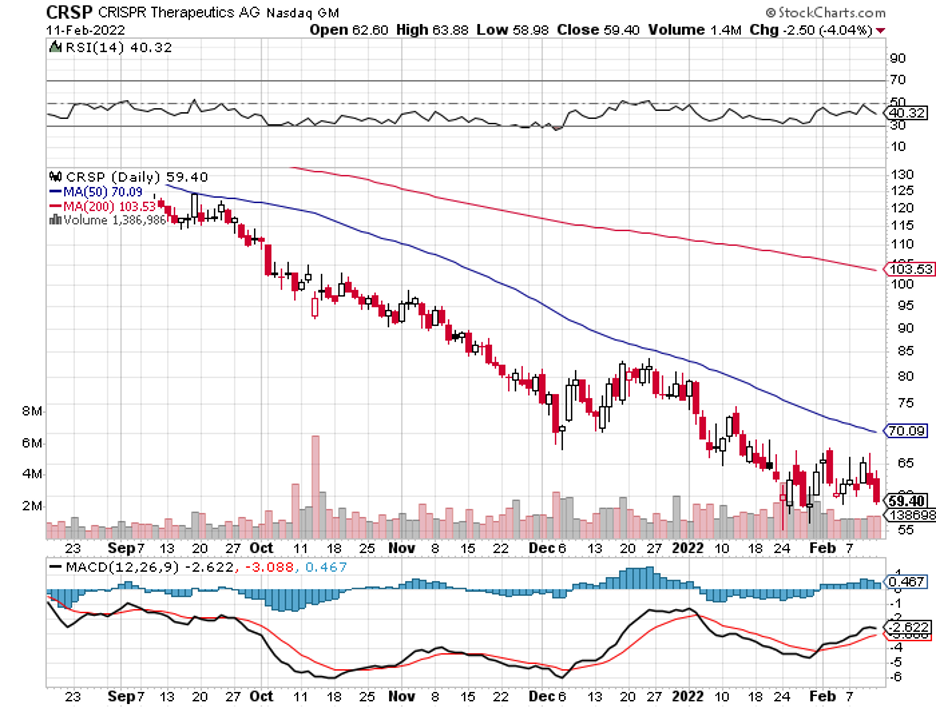
Mad Hedge Biotech and Healthcare Letter
February 8, 2022
Fiat Lux
Featured Trade:
(A NEW WAVE OF GENE-EDITING EXPERTS)
(NTLA), (REGN), (VRTX), (CRSP), (TMO), (SGMO), (EDIT), (MRK), (BIIB)

The gene-editing sector quietly achieved historical results in 2021. Last year, human trials of two in vivo CRISPR-centered treatments released promising data.
One study, conducted by Intellia Therapeutics (NTLA) and Regeneron Pharmaceuticals (REGN), worked on targeting the faulty gene responsible for transthyretin amyloidosis.
Using their new CRISPR-based therapy, they were able to record an impressive 96% decline in the transthyretin gene.
This is an impressive accomplishment not only for its high efficacy but also for the mere fact that no other work has managed to record any significant effect on the gene for almost a decade now.
The other study is by Vertex Pharmaceuticals (VRTX) and CRISPR Therapeutics (CRSP). Over the years, the two have been collaborating on coming up with treatments for various rare diseases.
In 2021, they recorded promising results in their clinical trials for sickle cell disease and beta-thalassemia. Aside from the potency of these treatments, there is a possibility that the effects would offer long-lasting improvements in the patients' lives.
While 2021 was clearly a remarkable year for the gene-editing sector, all signs indicate an even better 2022.
If the sector doesn’t deliver, there will be 2023 and the year after. After all, the gene-editing world is the kind of space that gets better with age.
More than that, this sector will keep evolving and attracting new players every year.
Hence, key players like Thermo Fisher Scientific (TMO), Sangamo Therapeutics (SGMO), Editas Medicine (EDIT), Merck (MRK), and Oxford Genetics cannot expect to be the top names in the industry forever.
Recently, some names have been making waves in the gene-editing industry.
One is Excision BioTherapeutics. Founded in 2015, this Philadelphia biotechnology company leverages its CRISPR-based platform to target viral infections.
Basically, they aim to snip the viral DNA out of the host genome.
To date, the company’s most advanced project is its HIV treatment: EBT-101. So far, Excision has managed to functionally cure its test animals of the infection by removing their HIV genomes.
Ultimately, Excision’s goal is to come up with a “one-and-done” therapy for viral diseases.
Apart from working on HIV treatments, the company is also looking into potential cures for herpes simplex, hepatitis B, and a rare brain infection called multifocal leukoencephalopathy.
If these treatments succeed, Excision’s therapies would be available in highly specialized treatment centers.
Another promising biotechnology company is California’s Scribe Therapeutics, which was founded in 2018.
Describing their approach to be guided with an “engineer first” philosophy, Scribe’s plans to use CRISPR-based gene-editing tools to achieve their goals.
Instead of using the conventional CRISPR-Cas9 methods, the company opts for modified versions of the RNA-guided genome editors or CasX enzymes.
Scribe has been developing these CasX enzymes to ensure that they acquire the qualities of the target for enhanced specificity.
That is, the company wants its “editor” to learn as much as possible about the characteristics of the system to deliver intentionally designed solutions.
Simply, Scribe aims to control all elements and eliminate the need to leave anything to chance or even nature.
Since its founding, Scribe has been actively developing solutions for unmet medical needs.
For instance, it has been working with Biogen (BIIB) to develop and eventually market CRISPR-based treatments that target an underlying genetic component of a nervous system disease called amyotrophic lateral sclerosis.
The agreement states that Scribe will get $15 million upfront and receive over $400 million in potential milestone payments.
The company has already started testing its technology in mouse models, focusing on neurological and neurodegenerative conditions.
Given their current trajectory, Scribe expects to release data by the third or fourth quarter of 2022 or early 2023.
All in all, gene-editing tools have evolved so much from the mid-twentieth century. Back in the 1970s and 1980s, the process of gene targeting was only possible in experiments on mice.
Since then, the ever-expanding world of science has pushed the sectors of gene analysis and manipulations to cover all kinds of cells and organisms.
Considering the increasing demand in this sector, it’s no wonder the gene-editing world has been growing at breakneck speed over the past years—a pace that won’t slow down anytime soon.

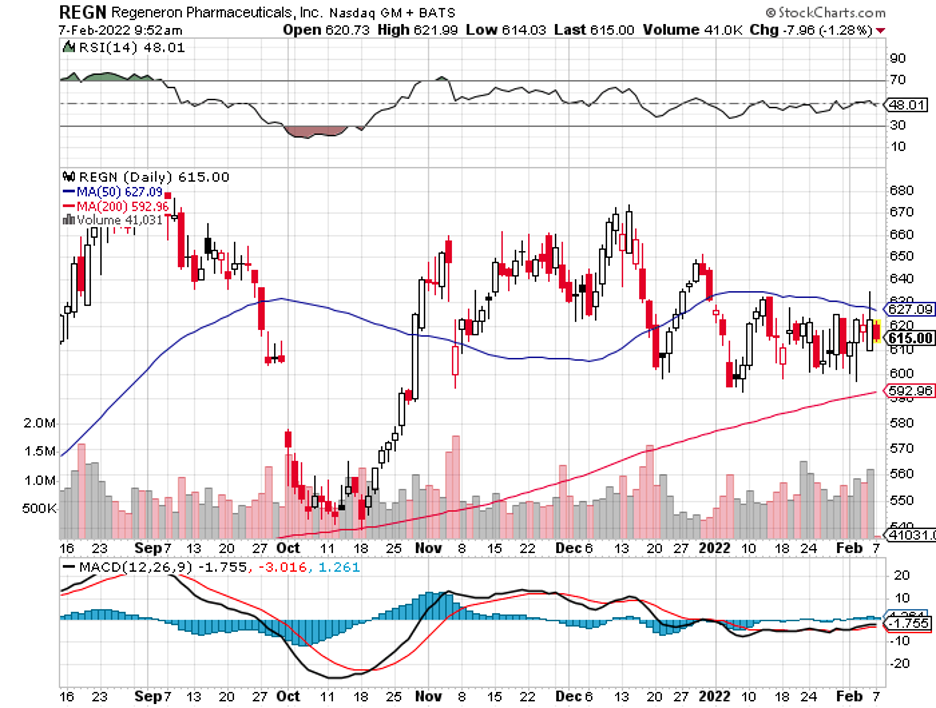
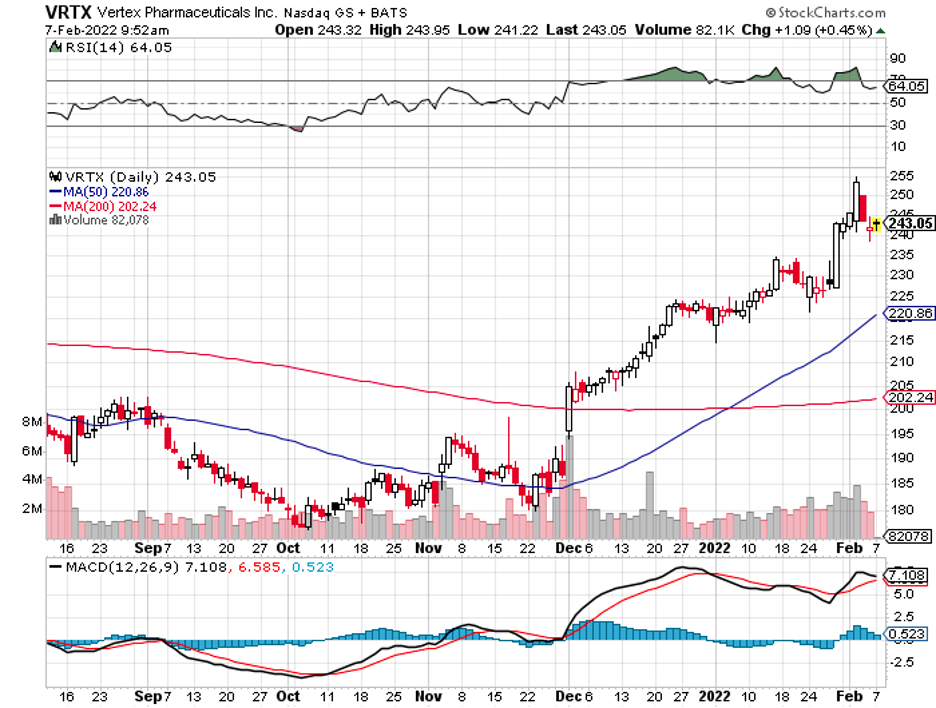
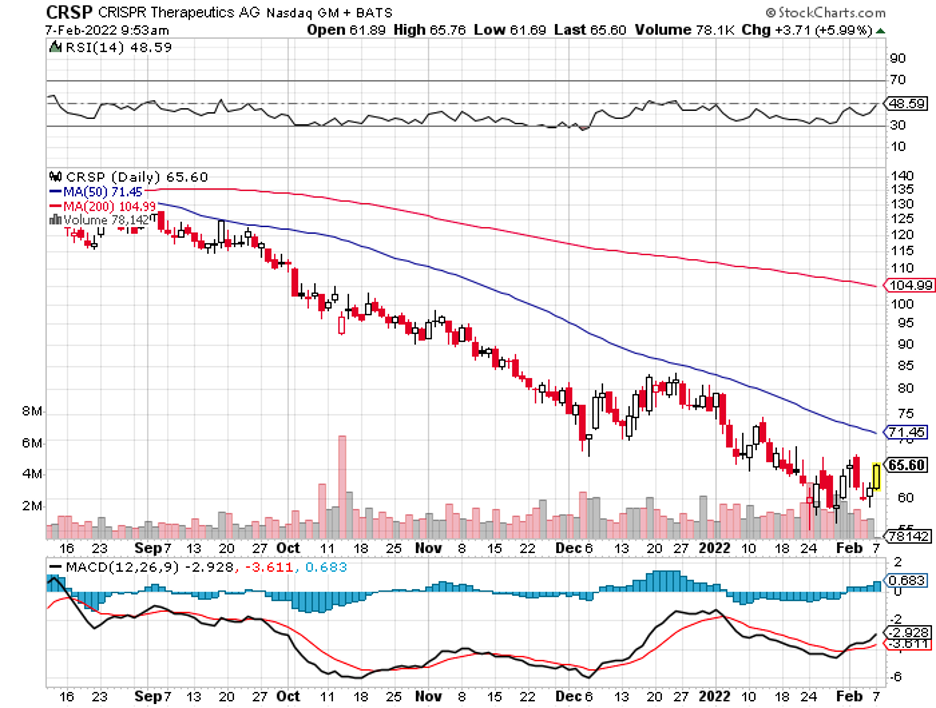
Mad Hedge Biotech & Healthcare Letter
August 24, 2021
Fiat Lux
FEATURED TRADE:
A GENE EDITING PURE PLAY UP FOR GRABS
(MRNA), (EDIT), (CRSP), (NTLA), (VRTX), (REGN), (BMY),
(BLUE), (NVO), (GRTS), (INBX), (BEAM), (VERV), (SGMO)

Moderna (MRNA) is faced with a dilemma. And it’s a pretty good problem to face at this point.
The biotechnology company has a flourishing cash stockpile courtesy of the increasing demand for its COVID-19 vaccine, and it needs to find something to do with its overflowing cash.
As of the end of the second quarter, the company has already reported a cash position of over $12 billion—a figure that offers Moderna the flexibility to go on a bit of a shopping spree.
So far, Moderna has set its sights on expanding its internal R&D programs on top of the $1 billion share repurchase program approved by its board of directors.
However, the most exciting news is the company’s plans to potentially make acquisitions soon.
This is where Editas Medicine (EDIT) enters the picture.
Moderna has not been shy in declaring that it wants to add gene editing therapies to its growing pipeline along with nucleic acid technologies and mRNA.
While Moderna did not specifically mention Editas in its plans, the smaller biotechnology company looks to be the most promising candidate for acquisition, especially if the COVID-19 vaccine leader plans to jump right into the action in the gene editing space.
After all, there are only three companies in this segment with therapies under clinical testing: CRISPR Therapeutics (CRSP), Intellia Therapeutics (NTLA), and Editas.
CRISPR Therapeutics is practically joined at the hip with Vertex Pharmaceuticals (VRTX). Meanwhile, Intellia has a strong ongoing partnership with Regeneron (REGN).
That leaves Editas, which currently has no partner for its lead program, making it a prime buyout candidate for Moderna.
Editas is also the cheapest by far among all three clinical-stage biotech with $4.12 billion in market capitalization.
In comparison, CRISPR Therapeutics has a market cap of $8.93 billion, while Intellia has a market cap of $10.97 billion.
Moderna could find Editas’ lower market capitalization as an add-on, as it would allow the bigger biotech to not spend all its cash on the acquisition.
Moreover, Editas has another advantage.
While both CRISPR Therapeutics and Intellia only focus on CRISPR-Cas9, which is a way to locate and bind targeted genes, Editas has developed another option platform to do that.
Its alternative option, called Cas12, could boost the company’s capacity to develop gene editing treatments.
Simply put, its rivals only have one weapon in their arsenal, while Editas has come up with a dual-option CRISPR platform to double its chances of succeeding in gene therapy development.
If, for instance, Moderna does not acquire Editas, there are still a lot of options available for the bigger company.
One possibility is with Juno Therapeutics, which is part of Bristol-Myers Squibb (BMY), as the company is already collaborating with Editas on the development of genetically modified T-cells to come up with a powerful cancer therapy.
Meanwhile, if Editas’ pipeline and portfolio do not quite cut it with Moderna, another potential buyout candidate for this biotechnology giant is bluebird bio (BLUE).
While it’s not as advanced as CRISPR Therapeutics, Intellia, and Editas, bluebird bio has ongoing work with the likes of Bristol-Myers Squibb, Regeneron, Novo Nordisk (NVO), Gritstone Oncology (GRTS), and Inhibrx (INBX).
Other candidates that Moderna could take into consideration include Beam Therapeutics (BEAM), Verve Therapeutics (VERV), and Sangamo Therapeutics (SGMO).
Regardless of Moderna’s future decisions, its announcements that it plans to expand on the gene editing space could potentially spur other huge biopharmaceutical companies to explore their own business development agreements with up-and-coming biotechnology firms.
In fact, even if Moderna ends up not calling, there’s a big possibility that Editas could easily find others who will be interested in acquiring this pure play gene editing frontrunner.
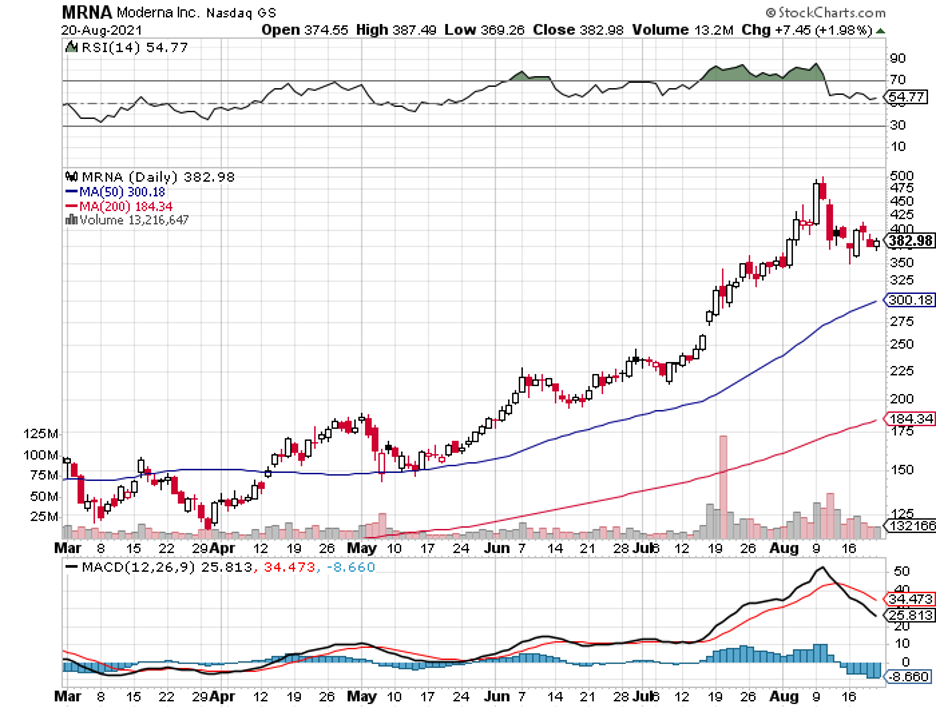
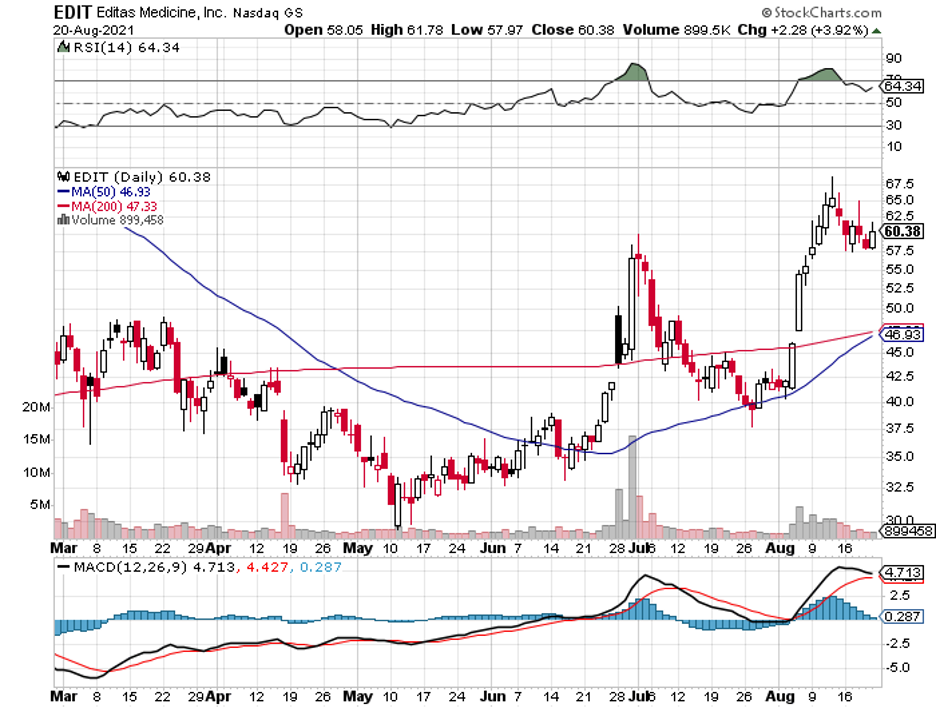
Mad Hedge Biotech & Healthcare Letter
April 27, 2021
Fiat Lux
FEATURED TRADE:
(THE FUTURE OF MEDICINE)
(CRSP), (VRTX), (EDIT), (NTLA), (PFE), (NVS), (GILD), (RHHBY),
(BMRN), (QURE), (SGMO), (CLLS), (ALLO), (BEAM)

Winning the Nobel Prize in 2020 provided biotechnology companies more traction on Wall Street.
The victory led to commercializing the 2012 discovery, Crispr-Cas9, at breakneck speed, with gene editing companies like CRISPR Therapeutics (CRSP), Editas Medicine (EDIT), and Intellia Therapeutics (NTLA) gaining considerable boost in their values.
Since then, the total market value for the products of these three has more than doubled in recent months to reach $23 billion.
Basically, Crispr-Cas9 functions like molecular scissors.
What makes this technology incredible is that Crispr-Cas9 can classify a single address out of 3 billion letters within the genome by using only a particular sequence. With this, we can repair thousands of genetic conditions and even offer more potent ways to battle cancer.
The market favorite among the gene editing companies so far is CRISPR Therapeutics, with $8.72 billion in market capitalization.
In comparison, Editas has $2.76 billion while Intellia Therapeutics has $4.15 billion.
CRISPR Therapeutics is currently working on a treatment that would implant tumor-targeting immune cells in cancer patients. The company is also prioritizing therapies that could edit cells to treat diabetes.
So far, it has made significant progress in developing treatments for a genetic disorder called sickle cell.
In the US alone, at least 100,000 people suffer from sickle cell disease, with 4,000 more born every year. Conservatively, we can estimate at least 3,000 patients availing of this one-time treatment at over $1.6 million a pop.
To date, CRISPR Therapeutics has five candidates under clinical trials for diseases like B-thalassemia, sickle cell disease, and other regenerative conditions.
It has four more queued, which target diabetes, cystic fibrosis, and Duchenne muscular dystrophy.
Compared to its rivals in the space, it’s clear that CRISPR Therapeutics is ahead when it comes to product development and trials.
Two of its candidates, transfusion-dependent beta thalassemia treatment CTX001 and sickle cell disease therapy CTX110, have already been submitted for clinical tests for safety and efficacy.
Recently, Vertex (VRTX) boosted its 2015 agreement with CRISPR Therapeutics by 10%, with the deal reaching $900 million upfront to push for quicker results in developing CTX001.
This is a crucial move for Vertex, but more so for CRISPR Therapeutics as CTX001 holds a highly lucrative addressable market.
The additional funding significantly widened the gap between the Vertex-CRISPR team and bluebird bio (BLUE) in the race to launch a new gene editing therapy targeting sickle cell disease and beta thalassemia.
To sustain its growth, CRISPR Therapeutics’ strategy is to develop drugs that only require mid-level complexity but can rake in generous financial rewards.
This is a similar tactic used by bigger and more established biotechnology companies like Pfizer (PFE), Novartis (NVS), and Gilead Sciences (GILD).
Evidently, this strategy is a great way to ensure cash flow.
Aside from its earning from the commercialization of these products, CRISPR Therapeutics can also attract larger companies to buy the intellectual property of their breakthrough treatments.
After all, startups generally get 100% premiums in contracts with Big Pharma.
Good examples of this are Novartis that bought AveXis and Roche’s (RHHBY) purchase of Spark Therapeutics.
The Roche-Spark agreement led to the first-ever FDA-approved treatment since gene therapy trials started in the 1990s. It was for the genetic blindness therapy Luxturna, which received the green light in 2017.
The second approved treatment was a muscle-wasting disease therapy Zolgensma, which was the fruit of the Novartis-Avexis acquisition.
Both conditions are rare, but the financial rewards are impressive.
At $2 million for each treatment, Zolgensma sales reached $1.2 billion annually. At the rate the therapy is selling, Novartis estimates that Zolgensma will surpass the $2 billion mark in 2021.
Novartis and Roche aren’t the only ones partnering with smaller gene editing companies.
Pfizer has been working with biotechnology companies BioMarin Pharmaceutics (BMRN) and UniQure (QURE) to develop a treatment for blood-clotting disorder hemophilia.
The COVID-19 frontrunner is also collaborating with Sarepta Therapeutics (SRPT) to come up with a treatment for Duchenne muscular dystrophy.
Gene editing has also served as the foundation for several biotechnology companies out there today like Sangamo Therapeutics (SGMO), Cellectis (CLLS), and Allogene Therapeutics (ALLO).
The market size for gene editing treatments is estimated to be worth $11.2 billion by 2025, with the number rising between $15.79 billion to $18.1 billion by 2027.
This puts the compounded annual growth rate of this sector to be at least roughly 17%.
While this is already groundbreaking with only a handful of companies knowing how to utilize the technology, the gene editing world has come up with a more advanced technique than Crispr-Cas9.
The technology is founded on the “base editing” or “prime editing” technique, which is the simplest type of gene editing that alters only one DNA letter.
So far, one company holds exclusive rights to this technology: Beam Therapeutics (BEAM).
When the technology became public, Beam stock has increased sixfold since its IPO in February 2020.
This latest development can resolve thousands of genetic diseases. However, it still requires further trials since “base editing” can also trigger damaging responses from the body.
Overall, I think CRISPR Therapeutics is the safest among these high-risk stocks.
The data from two of its candidates, CTX001 and CTX110, are incredibly promising. Plus, the added funding from Vertex boosts the confidence of investors that regulatory approval is well on its way.
The company is also capitalizing on the surging price of its stock and investing aggressively across different rare disease programs.
While the company has yet to be considered a major force in the biotechnology world, the potential multiple successes of its products could generate a company worth hundreds of billions.
This potential alone offers an investing opportunity with a substantial asymmetric advantage for its current share price.
However, bear in mind that the stock is still a risk and should be played as a long-term investment. Hence, you should buy on dips.
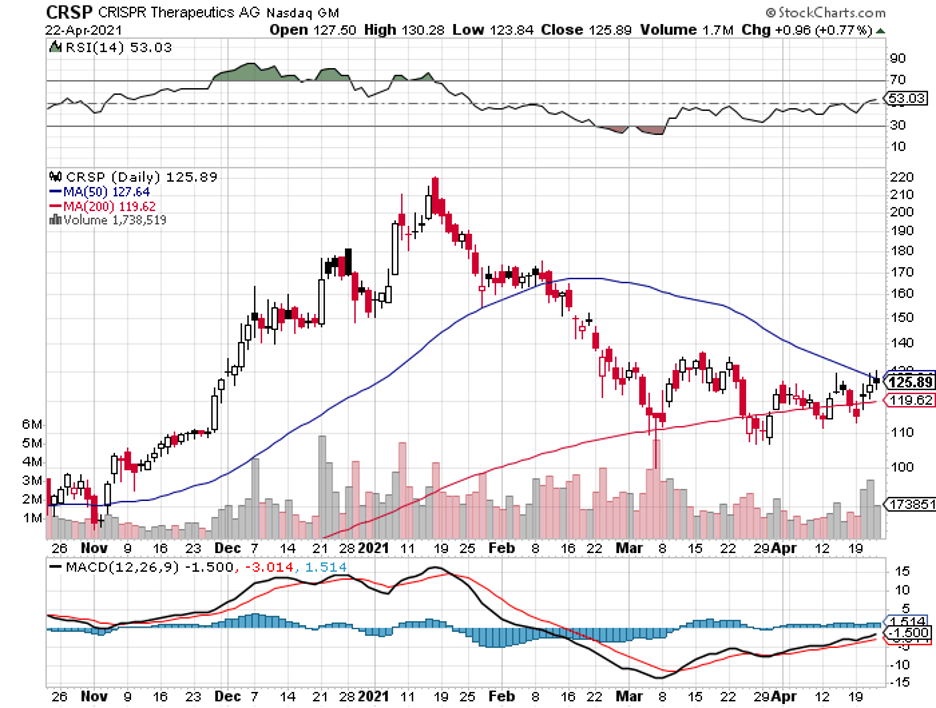
Mad Hedge Biotech & Healthcare Letter
July 16, 2020
Fiat Lux
Featured Trade:
(BIOGEN’S LONG TERM UPSWING HAS BEGUN),
(BIIB), (SGMO), (RHHBY)

Biogen (BIIB) is a stock that perfectly fits the biotechnology mold.
Over the past 5 years, this Massachusetts-based company was down for roughly 25%. Five years before that though, Biogen stock catapulted 700%. A decade or so prior that, the company’s performance was flat, with a couple of extreme swings now and then.
However, the next decade could see Biogen stocks going upswing once again.
In the past 20 years, the biotechnology and healthcare sectors have been obsessed with finding a cure for cancer. With over 1.8 million fresh cases diagnosed every year, it’s understandable why the oncology space has received the most attention over the years.
Apart from cancer, companies have also made significant progress in other pressing issues like infectious diseases and cardiovascular disorders.
Now, a new market is starting to demand attention as well: the neuroscience field.
With all the demands for treatments for other diseases though, companies pulled R&D dollars away from the neuroscience budget and poured those into less risky efforts.
In comparison, Biogen doubled down spending on its neurology research.
In fact, the company has spent over $10 billion in this sector in the last 5 years. This amounts to roughly 5% of its annual market capitalization.
To bolster its neuroscience efforts, Biogen is investing in gene therapy as drivers of future growth.
Just last April, the company bought $225 million of Sangamo Therapeutics (SGMO) stock. On top of that, Biogen paid the smaller company $125 million for technology licensing. The deal also included up to $2.37 billion in royalties and milestone payments.
This newly established collaboration will see Sangamo working with Biogen to come up with gene therapies for various disorders, including Alzheimer’s disease and Parkinson’s disease.
At the moment, Biogen is focusing on the development of its Alzheimer’s treatment Aducanumab.
Alzheimer’s is a huge untapped market opportunity that presents a substantial unmet clinical demand. Right now, there are no approved treatments that could alter the natural progression of the disease.
In the US alone, there are more than 5.8 million people living with Alzheimer’s and about 500,000 new cases added annually.
This target makes Biogen’s Alzheimer’s treatment Aducanumab a potential mega-blockbuster.
Biogen’s estimated annual cost per patient for Aducanumab is $30,000.
With the number of Alzheimer’s patients in the US at the moment, back of the napkin math shows that Aducanumab can easily generate $15 billion in sales for Biogen.
Meanwhile, peak sales for this treatment could hit $20 billion — and this could even be an underestimate.
Projecting it further to 10 years down the line and putting Biogen’s market penetration at just 50%, assuming that the number of cases remains flat, then Aducanumab could reach 2.9 million users.
This means an annual astronomical cost of $87 billion for the Alzheimer’s market.
Let’s say Biogen is eventually asked to lower the price for the treatment to be accommodated by Medicare.
We use just a third of the $30,000, which puts the Alzheimer’s treatment at $10,000 each year for every patient instead. This would still rake in an impressive $29 billion for Biogen -- and these numbers only cover the US.
If we assume that the demand from the rest of the world matches the US sales, then global demand for Aducanumab could generate over $60 billion in a year based on our $10,000 per patient each year estimate.
Going back to Biogen’s initial $30,000 projection, then annual sales would reach a jaw-dropping $180 billion.
Sticking to the $60 billion per year estimate, Biogen can easily climb to $250 billion in market capitalization in the next 10 years --- an incredible jump from the $42.79 billion it has right now. The company’s shares could trade north of $1,500, providing its investors with over 400% return.
As a Roche (RRHBY) leader aptly described, “neuroscience has the potential to be in the ‘20s what oncology has been in the last decade.”
Now, Biogen is the undisputed leader in terms of pipeline candidates for the field. It has transformed itself into a research powerhouse in anticipation of its dominance in what could be the most important medical breakthroughs over the next decade or two.
After all, scientific breakthroughs allow us to live longer. In effect, a good part of our population will eventually face neurological problems that crop up later in life.
Hence, Biogen is poised to lead the charge in this grossly underserved market. The fact that the company has been keeping its pedal to the metal in terms of its R&D efforts further all but guarantees its dominance in the years to come.
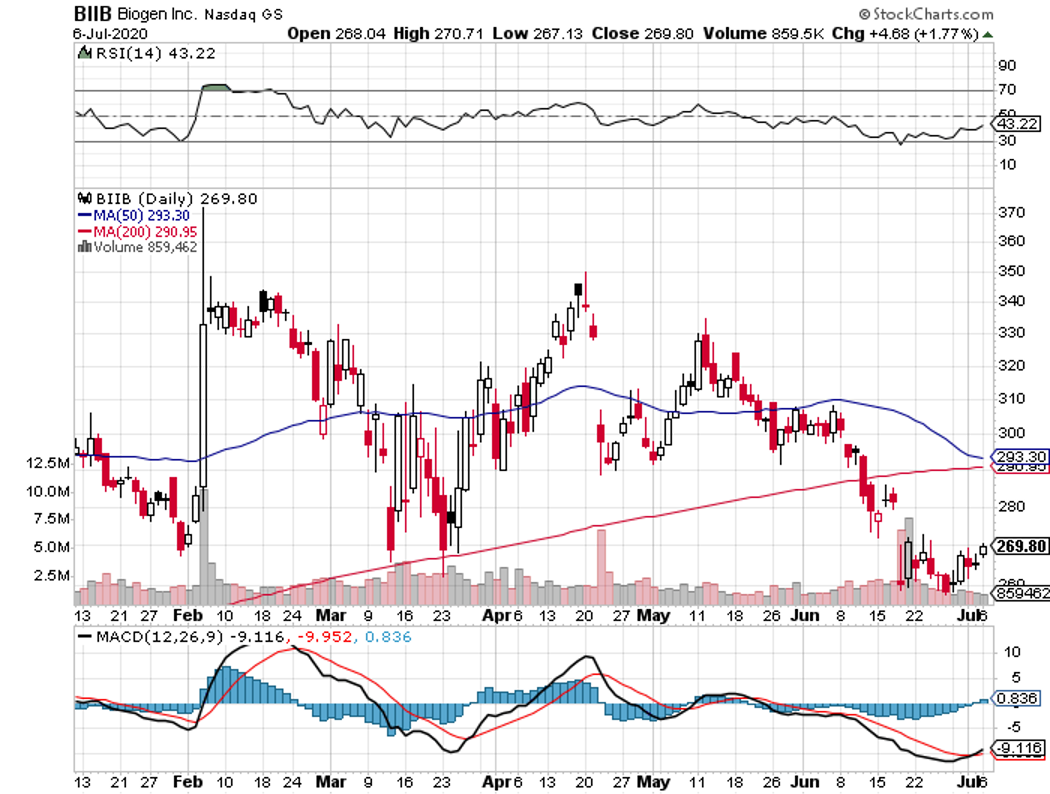
Legal Disclaimer
There is a very high degree of risk involved in trading. Past results are not indicative of future returns. MadHedgeFundTrader.com and all individuals affiliated with this site assume no responsibilities for your trading and investment results. The indicators, strategies, columns, articles and all other features are for educational purposes only and should not be construed as investment advice. Information for futures trading observations are obtained from sources believed to be reliable, but we do not warrant its completeness or accuracy, or warrant any results from the use of the information. Your use of the trading observations is entirely at your own risk and it is your sole responsibility to evaluate the accuracy, completeness and usefulness of the information. You must assess the risk of any trade with your broker and make your own independent decisions regarding any securities mentioned herein. Affiliates of MadHedgeFundTrader.com may have a position or effect transactions in the securities described herein (or options thereon) and/or otherwise employ trading strategies that may be consistent or inconsistent with the provided strategies.
This site uses cookies. By continuing to browse the site, you are agreeing to our use of cookies.
OKLearn moreWe may request cookies to be set on your device. We use cookies to let us know when you visit our websites, how you interact with us, to enrich your user experience, and to customize your relationship with our website.
Click on the different category headings to find out more. You can also change some of your preferences. Note that blocking some types of cookies may impact your experience on our websites and the services we are able to offer.
These cookies are strictly necessary to provide you with services available through our website and to use some of its features.
Because these cookies are strictly necessary to deliver the website, refuseing them will have impact how our site functions. You always can block or delete cookies by changing your browser settings and force blocking all cookies on this website. But this will always prompt you to accept/refuse cookies when revisiting our site.
We fully respect if you want to refuse cookies but to avoid asking you again and again kindly allow us to store a cookie for that. You are free to opt out any time or opt in for other cookies to get a better experience. If you refuse cookies we will remove all set cookies in our domain.
We provide you with a list of stored cookies on your computer in our domain so you can check what we stored. Due to security reasons we are not able to show or modify cookies from other domains. You can check these in your browser security settings.
These cookies collect information that is used either in aggregate form to help us understand how our website is being used or how effective our marketing campaigns are, or to help us customize our website and application for you in order to enhance your experience.
If you do not want that we track your visist to our site you can disable tracking in your browser here:
We also use different external services like Google Webfonts, Google Maps, and external Video providers. Since these providers may collect personal data like your IP address we allow you to block them here. Please be aware that this might heavily reduce the functionality and appearance of our site. Changes will take effect once you reload the page.
Google Webfont Settings:
Google Map Settings:
Vimeo and Youtube video embeds:
